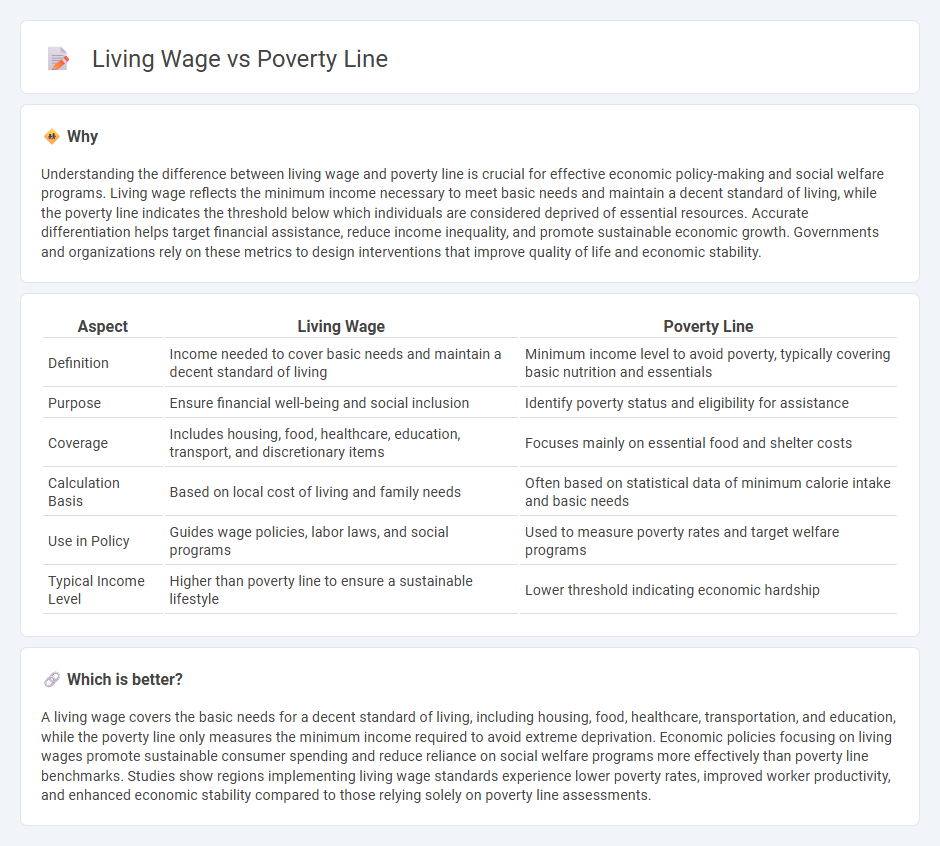
The living wage reflects the minimum income required for individuals to afford basic necessities such as housing, food, and healthcare, ensuring a decent standard of living. In contrast, the poverty line defines the income threshold below which people are considered economically disadvantaged and unable to meet essential needs. Explore how these metrics influence social policies and economic stability worldwide.
Why it is important
Understanding the difference between living wage and poverty line is crucial for effective economic policy-making and social welfare programs. Living wage reflects the minimum income necessary to meet basic needs and maintain a decent standard of living, while the poverty line indicates the threshold below which individuals are considered deprived of essential resources. Accurate differentiation helps target financial assistance, reduce income inequality, and promote sustainable economic growth. Governments and organizations rely on these metrics to design interventions that improve quality of life and economic stability.
Comparison Table
| Aspect | Living Wage | Poverty Line |
|---|---|---|
| Definition | Income needed to cover basic needs and maintain a decent standard of living | Minimum income level to avoid poverty, typically covering basic nutrition and essentials |
| Purpose | Ensure financial well-being and social inclusion | Identify poverty status and eligibility for assistance |
| Coverage | Includes housing, food, healthcare, education, transport, and discretionary items | Focuses mainly on essential food and shelter costs |
| Calculation Basis | Based on local cost of living and family needs | Often based on statistical data of minimum calorie intake and basic needs |
| Use in Policy | Guides wage policies, labor laws, and social programs | Used to measure poverty rates and target welfare programs |
| Typical Income Level | Higher than poverty line to ensure a sustainable lifestyle | Lower threshold indicating economic hardship |
Which is better?
A living wage covers the basic needs for a decent standard of living, including housing, food, healthcare, transportation, and education, while the poverty line only measures the minimum income required to avoid extreme deprivation. Economic policies focusing on living wages promote sustainable consumer spending and reduce reliance on social welfare programs more effectively than poverty line benchmarks. Studies show regions implementing living wage standards experience lower poverty rates, improved worker productivity, and enhanced economic stability compared to those relying solely on poverty line assessments.
Connection
The living wage represents the minimum income necessary for individuals to meet basic needs such as housing, food, and healthcare, while the poverty line is an official threshold defining the minimum income level to avoid poverty. Both concepts are closely connected as the living wage sets a practical standard above the poverty line to ensure a decent quality of life. Policies aimed at raising the living wage directly influence poverty reduction by enabling more workers to surpass the poverty line.
Key Terms
Income threshold
The poverty line defines the minimum income level necessary to meet basic needs such as food, shelter, and clothing, while the living wage represents a higher income threshold sufficient for a decent standard of living, including healthcare, education, and discretionary spending. Poverty lines vary by country and methodology, often set by governmental or international organizations, whereas living wage calculations incorporate local cost of living data and family size considerations. Explore further to understand how these income thresholds impact social policy and economic well-being.
Cost of living
The poverty line measures the minimum income needed to avoid extreme deprivation, while a living wage reflects the earnings required to cover basic living expenses such as housing, food, healthcare, and transportation within a specific cost-of-living context. Cost of living varies significantly by region, influencing the gap between poverty thresholds and living wage standards, which often outpace inflation and government-set poverty measures. Explore how adjusting living wages based on local cost-of-living data impacts economic stability and social equity.
Basic needs
The poverty line represents the minimum income level required to meet basic survival needs such as food, shelter, and clothing, while a living wage encompasses a broader range of essential expenses including healthcare, education, and transportation, ensuring a decent standard of living. Basic needs are often narrowly defined in the poverty line, whereas a living wage reflects real-world costs that support economic security and well-being. Explore the differences and implications of these concepts to better understand social and economic policies.
Source and External Links
Poverty threshold - Wikipedia - The poverty line is the minimum income deemed adequate in a country, typically based on the cost of necessities like housing and adjusted by individual factors, with the global absolute minimum updated by the World Bank to $2.15 per day in PPP as of 2022.
How the Census Bureau Measures Poverty - The U.S. Census Bureau defines poverty by comparing family income to a set of income thresholds that vary by family size and composition, updated annually for inflation but not geographically.
How is poverty measured? - In the U.S., poverty is measured by the Official Poverty Measure comparing pre-tax cash income against poverty thresholds, which are adjusted by family makeup, with the 2023 poverty rate at 11.1%.
 dowidth.com
dowidth.com